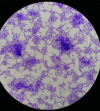Interference of Lactobacillus casei with Pseudomonas aeruginosa in the treatment of infected burns in Wistar rats
- PMID: 33953852
- PMCID: PMC8061325
- DOI: 10.22038/IJBMS.2020.47447.10920
Interference of Lactobacillus casei with Pseudomonas aeruginosa in the treatment of infected burns in Wistar rats
Abstract
Objectives: Burns are the most common type of trauma with a high mortality rate worldwide. The use of modern and natural medicines, especially probiotic products, has been recently considered for cutaneous wound healing. The present study was designed to investigate the effect of Lactobacillus casei on wound healing caused by Pseudomonas aeruginosa.
Materials and methods: In this study, the anti-adhesion activity of L. casei was examined by the glass slide method, and inhibitory substances in the cell-free supernatant (CFS) were quantified by high-performance liquid chromatography (HPLC). Following the induction of second-degree wounds, multidrug-resistant (MDR) P. aeruginosa was injected subcutaneously and directly on the burn. The animals were divided into four groups. The supernatant of L. casei was sprayed for treatment every day and wound healing was examined.
Results: Based on our findings, the supernatant of L. casei showed considerable anti-adhesion effects on P. aeruginosa. HPLC analysis indicated that the inhibitory effect of this supernatant can be due to four main organic acids including lactic acid, acetic acid, citric acid, and succinic acid. The effect of treatment on fibroblastic cells showed that the treated group by supernatant of L. casei had more fibroblastic cells compared with the non-treated group. Moreover, this supernatant increased the rate of fibroblastic cells, re-epithelialization in the wound area, and the largest thickness of the epidermis and dermis layers.
Conclusion: The present findings showed that L. casei supernatant significantly reduced inflammation and could be used to treat P. aeruginosa infection in second-degree burns.
Keywords: Biofilms; Multidrug-resistant; Probiotics; Pseudomonas infections; Wound healing.
Figures






References
-
- Onarımında BB, Bir K. Use of scalp flaps as a salvage procedure in reconstruction of the large defects of head and neck region. Turk Neurosurg. 2012;22:712–717. - PubMed
-
- Rahimzadeh G, Seyedi DS, Fallah RF. Comparison of two types of gels in improving burn wound. Crescent J Medical Biol Sci. 2014;1:28–32.
-
- Velnar T, Bailey T, Smrkolj V. The wound healing process: an overview of the cellular and molecular mechanisms. J Int Med Res. 2009;37:1528–1542. - PubMed
LinkOut - more resources
Full Text Sources
